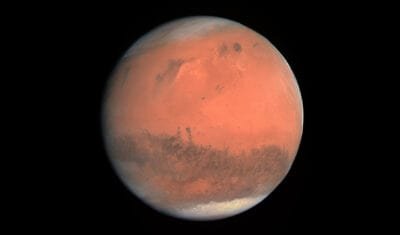AMBITIOUS PLANS WERE UNDERWAY during the autumn of 1877, which involved a series of mapping projects unlike any that had ever been seen on Earth. This was primarily because the area being mapped was no Earthly location: it was the surface of Mars.
Beginning on September 5, 1877, Mars was entering a period of opposition which brought it within 35 million miles of Earth. Although the last perihelic opposition had occurred just seventeen years earlier in 1860, much had changed since that time; this included the construction of telescopes the likes of a 26-inch refractor in the possession of the U.S. Naval Observatory. Also, just weeks earlier the discovery of the Martian moons Deimos and Phobos had been announced by astronomer Asaph Hall. With upgraded gear and new insights into the nature of Earth’s mysterious neighbor, astronomers around the world were eager for their next opportunity to glimpse an alien world.
Among those who had been mapping his observations at the time was an amateur astronomer and professional artist named Nathaniel Green, who was able to produce maps of the Red Planet from his vantage point on the island of Madeira using a 13-inch Newtonian reflector. Green’s maps were able to identify a number of features on the Martian surface, as other astronomers had succeeded in doing beforehand.
“At such periods not only has ice and snow been discovered near the poles of Mars, but continents and oceans, islands and lakes, have been seen and have been mapped out by Mr. Dawes, Mr. Procter, and other astronomers,” read a September 4, 1882 letter sent to the Manchester Guardian by Josiah Thomas Slugg, an astronomer and author of books on the construction and use of telescopes. However, it had been Italian astronomer Giovanni Virginio Schiaparelli whose recorded observations dating back to the time of the 1877 opposition that were the main focus of Slugg’s correspondence.
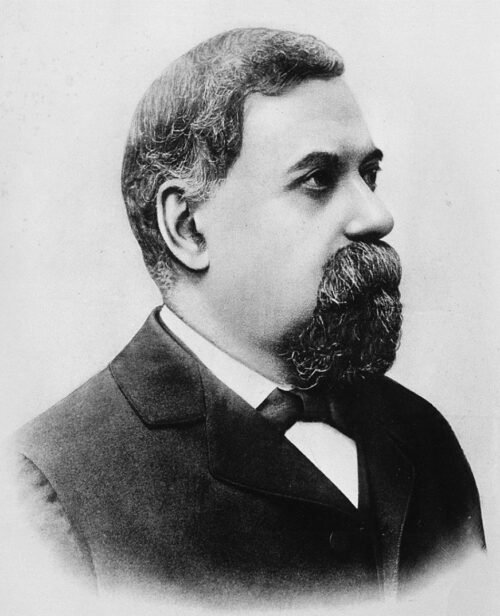

Citing the “unusually favorable circumstances at Milan, owning to the very clear sky enjoyed there at that time,” Slugg explained that “The director of the observatory there is Signor Schiaparelli, who has the command of a particularly fine telescope of large dimensions, and during 16 days he was able to use the highest power of the instrument. Not only was he able to detect important changes which had taken place on certain portions of the surface of Mars, but he made discoveries of a much more interesting nature.”
Beginning in September of 1877, Schiaparelli had observed and mapped features on the Martian surface which he likened to continents, oceans, and other features similar to those found on Earth, to which he gave mythological names. However, Schiaparelli also observed what he thought to be channels extending for great distances across its surface. Although Schiaparelli labeled these features “canali”, meaning “grooves” or “channels”, subsequent mistranslations conveyed these as being canals, which led many to believe they indicated either the past or present existence of intelligent life on Mars.
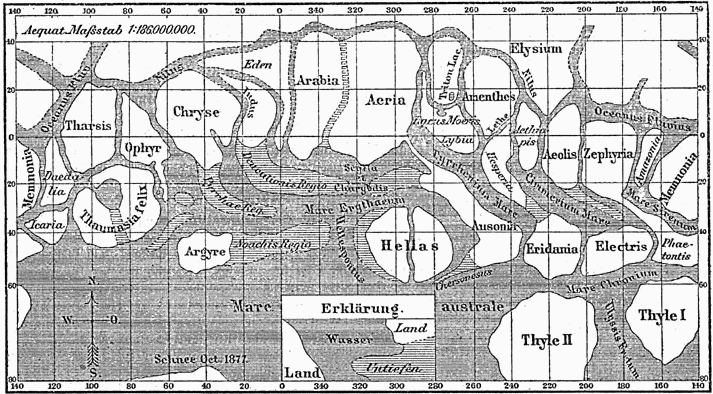

Schiaparelli’s observations would set the tone for Martian studies for decades to come. Although the “cannals” on Mars were ultimately proven to be an illusion, the Italian astronomer would not be the last to observe these features and speculate about the Martians who might have constructed them; speculations that would continue well into the next century.
NO OTHER PLANET IN our solar system has captivated the human imagination quite like Mars. Throughout time, it has been the setting of countless tales of science fiction, as well as a source of speculations about whether it has ever harbored life that continues to the present day. With humanity’s current spacefaring objectives, it has also become a destination which future generations of Earthlings might even one day call home.
Toward that eventuality, February 2021 may one day be recognized as the month Earthlings invaded the Red Planet (or at least sent their robots to do the job). Beginning on Feburary 9th with the arrival of the United Arab Emirates (UAE) Hope spacecraft, this month sees the arrival of three separate nations sending probes to Mars which will continue decades of studies of the planet, as well as its potential habitability for future long-term missions.
Our fascination with Mars has deep roots, which extend back well in advance of the 19th century observations of Schiaparelli and his contemporaries. Long associated with warfare, Mars is named after the Roman god of war and agriculture, although the Sumerians were likely the earliest to have associated the Red Planet with their god of war, Nergal. Other traditions like those recorded by the Mesopotamians associated it with judgement of deceased souls.
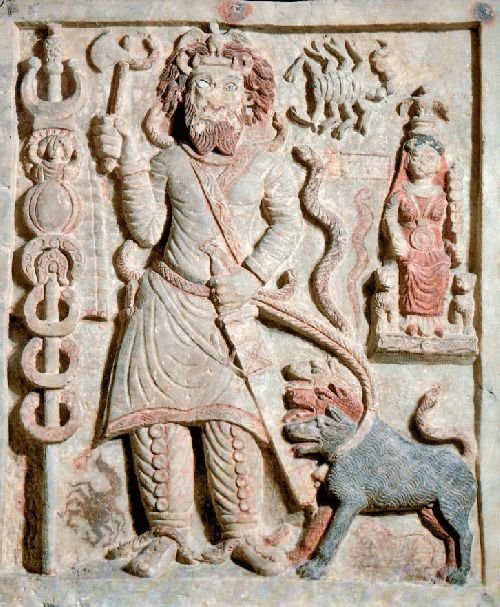

Many ancient observations of Mars account for it as a “wandering star” which changed its position in the sky differently from other celestial objects; the Egyptians had extensive records of its movements, as did ancient Babylonian astronomers. Observations that began to reveal details about its nature (which ancient observers did not yet recognize as being a planet) began in the middle 300s BC, when Aristotle noticed the occultation of Mars as it passed behind the moon, indicating its greater distance from Earth than our nearby satellite.
Telescopic observations of Mars began in 1609 with Galileo Galilei, who was unable to make out surface details during these early investigations. By the 1650s, observations made by Christiaan Huygens were detailed enough that he was able to produce sketches of the planet’s surface which included features recognizable today. In addition to his drawings of Mars, Huygens was able to discern from the movement of dark areas on the planet, or maria, that it rotated much like Earth does. Observations made by Huygens about the rotation of Mars were expanded upon by Giovanni Cassini the following decade, who also identified light colored areas at its poles which were believed to be icy accumulations, similar to Earth’s polar regions. By 1719, Ciacomo Maraldi (the nephew of Cassini) noticed gradual changes in these polar caps, which he interpreted as evidence of seasons on Mars, a notion that would be confirmed more than half a century later by astronomer William Herschel.
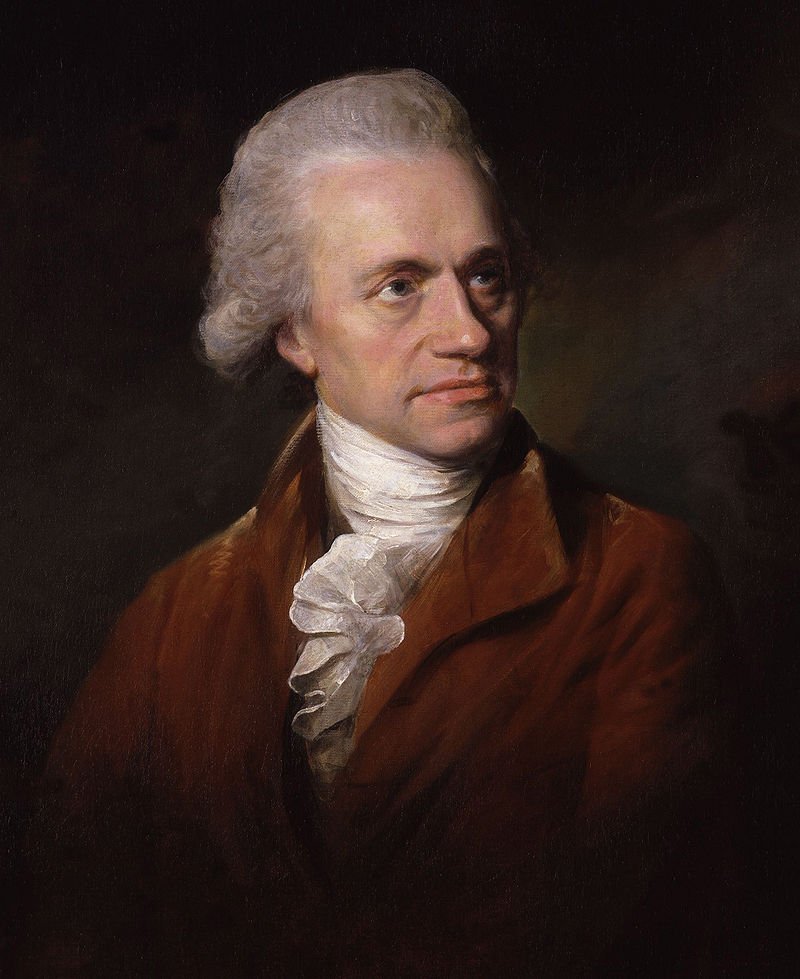

While Herschel had been able to confirm the changing seasons on Mars, he would also be among the many astronomers that would perceive the darkened maria regions on Mars as evidence of oceans. However, if these regions represented large bodies of water, why did their appearance periodically change, much like the polar areas? Herschel proposed that this could be evidence of flooding, or perhaps that drifting cloud coverage over Mars might account for such changes.
The idea of whether Mars could be home to intelligent beings had not been left out of the discussion prior to the 19thcentury. Building on the mounting interests during the 18th century about the existence of life on other worlds, one example of this can be found in Emmanuel Swedenborg’s 1758 treatise Other Planets (Earths in the Universe), where he had written of his knowledge of the Martian inhabitants gleaned through spiritual means, about which he tells us that:
“Of all the spirits who come from the earths of this solar system, those of Mars are the best, being for the most part celestial men, not unlike those who were of the Most Ancient Church on this Earth. When they are represented as to their quality, they are represented with the face in heaven and the body in the world of spirits; and those of them who are angels are represented with the face towards the Lord and the body in heaven.”
Swedenborg’s revelations about the spiritual nature of Martians were among the earliest musings about the implications of theology pertaining to the existence of Martians, although the real debate over whether life existed on the Red Planet would not begin until more than a century later.
BY THE MIDDLE OF the nineteenth century, ideas about the changing appearance of Mars would begin to incorporate notions of life on the Red Planet. The earliest speculations in this regard had to do with vegetation, once Emmanuel Liais proposed that foliage might account for the observations of Herschel and others during the previous century. Immediately following Asaph Hall’s discovery of Deimos and Phobos, Schiaparelli would make his earliest observations of the “canali” in September 1877 during the perihelic opposition that occurred that year, which gave rise to the idea that such “canals” would require intelligent engineers on the Red Planet in order to have been constructed. Interestingly, Schiaparelli did not particularly hold this view, since his original wording had been meant to convey these lines more ambiguously as grooves, rather than clearly identifiable structures. However, like many of his contemporaries, he remained open minded about whether life existed on Mars.
For a time, Schiaparelli’s Martian canals appeared to have found independent verification in additional observations by astronomers the likes of Henri Joseph Perrotin and Louis Thollon, although their greatest advocate would be Percival Lowell, a well-connected American businessman who by 1894 had become so infatuated with the proposition of life on Mars that he decided to construct an observatory for the sole purpose of studying the Red Planet. After much scouting, the location chosen for Lowell’s observatory was Flagstaff, Arizona, where along with astronomer William Henry Pickering and his assistant, Andrew Douglass, Lowell began a systematic study of Mars that would last several years. Eventually Lowell would be offered a position at the Massachusetts Institute of Technology as a non-resident astronomer, and while his observations of Mars were valuable, he never divorced himself from theories involving the construction of canals by intelligent inhabitants of the Red Planet, publishing books on the topic that included his 1895 book Mars, followed by Mars and Its Canals (1906) and Mars as the Abode of Life (1908).
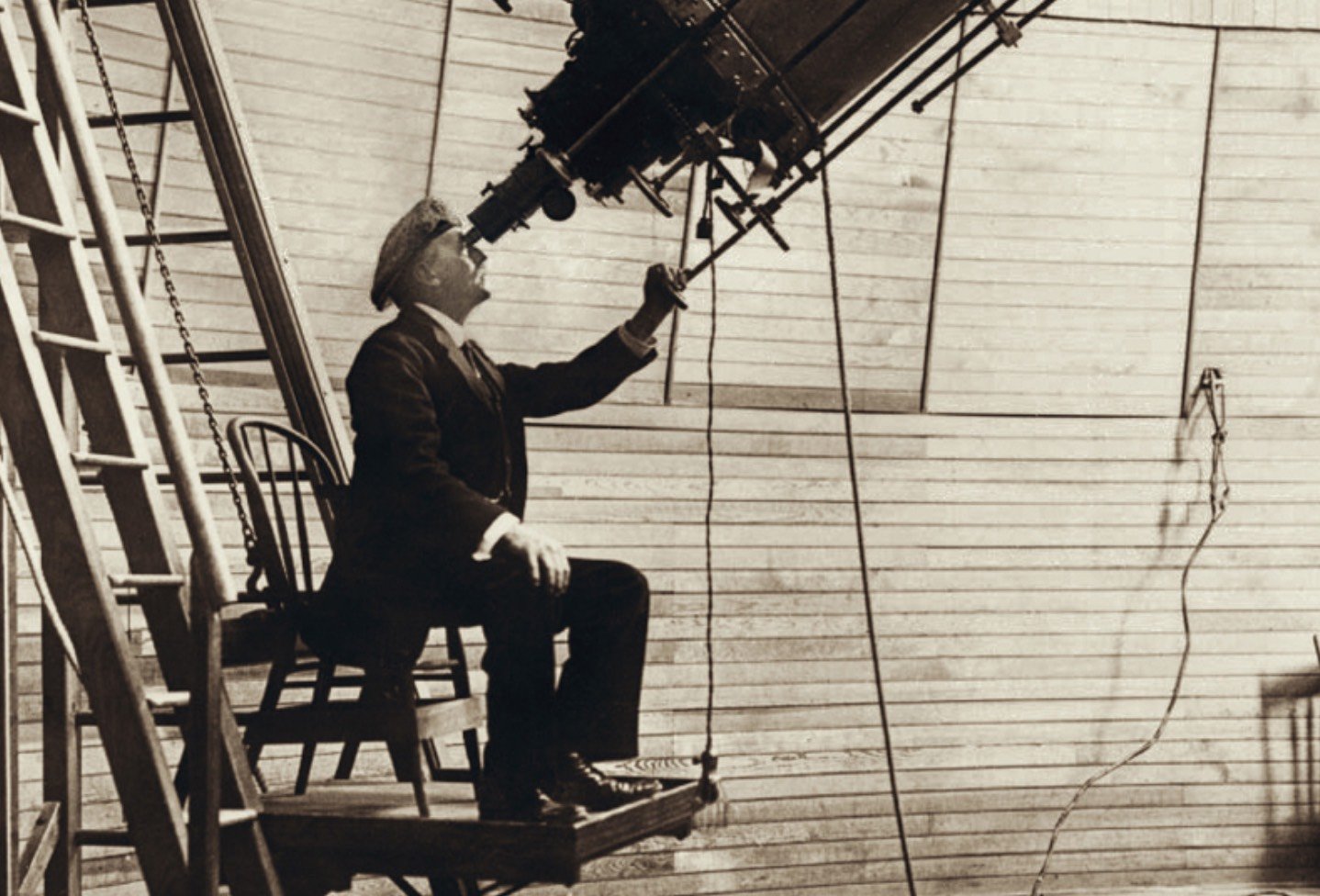

Dedicated to Schiaparelli, whom he called “The Columbus of a New Planetary World,” Lowell wrote in Mars and its Canals that the darkened regions of Mars were clear evidence of the lush flora which grew there. Further, he reasoned that the presence of vegetation, helped along by canals which he believed were built to irrigate the Red Planet, was sure evidence for intelligent beings who also dwelt there.
As Lowell explained:
“Not until the creatures had reached a certain phase in evolution would their presence become perceptible; and not then directly, but by the results such presence brought to pass. Occupancy would be first evidenced by its imprint on the land; discernible thus initially not so much by the bodily as by the mind’s eye. For not till the animal had learnt to dominate nature and fashion it to his needs and ends would his existence betray itself. By the transformation he wrought in the landscape would he be known. It is thus we should make our own far acquaintance; and by the disarrangement of nature first have inkling of man.”
Despite the popular appeal of Lowell’s writings, they were met with a fair amount of opposition from some members of the scientific community. Biologist Alfred Russel Wallace, calculating surface temperatures on the planet based on the amount of light it reflected, concluded that its average surface temperature would be -35 degrees Fahrenheit, making it far too cold to sustain vegetation, let alone an abundance of liquid water.
Not to be swayed from his convictions, Lowell continued to promote his theories about life on Mars, which caused the majority of scientists to become wary of further associations with him. Camille Flammarion was one exception, having been the astronomer whose own written work—namely his book La Planète Mars—had provided the spark which lit the fire under Lowell’s own interest in the Red Planet. It was also Flammarion who, in 1909, while making what were among the most detailed observations of Mars at that time, was unable to detect any of the canals Lowell and others had long championed. Schiaparelli’s “grooves” weren’t canals after all, and in fact did not even exist, having resulted from optical illusions rather than intelligent Martians attempting to hydrate their world.
IN THE EARLY DECADES of the 20th century, speculation continued as to the source of the subtle changes in the appearance of Mars throughout the year. However, the new century also arrived with new mediums for people’s fascination with the Red Planet, particularly in science fiction.
In fact, many of the science fictions musings that propelled Martians in early 20th century science fiction had begun to appear throughout the 1880s and 1890s. While Swedenborg and others had speculated about life on other worlds during the preceding century, what is likely the earliest true science fiction story involving a visit to Mars and interactions with its inhabitants was English political writer Percy Greg, whose novel Across the Zodiac presented the notable first use of the word astronaut, as well as a visit by such spacefaring Earthlings to Mars where they encountered the planet’s diminutive residents. Prior to his own observations that helped close the book on the idea of Martian canals, Flammarion’s own 1890 work Uranie told of a pair of Earthlings whose untimely death results in their reincarnation as Martians.
Other examples from prior to the 19th century existed too, although the appearance of H.G. Welles’ The War of the Worlds in 1898 marked a significant turning point for a number of reasons. As Greg had done beforehand with his introduction of astronaut into the English lexicon, Welles was, at very least, the first to popularize a hyphenated version of the word extraterrestrial, in reference to Martian craft that appear on Earth immediately prior to an ensuing invasion. Welles’ novel (which drew inspiration by the writings of Perceval Lowell) had also been among the earliest instances in fiction to represent aliens resembling cephalopods, another trope that would become a lasting feature in science fiction for decades to come. However, Welles had also capitalized on the idea of aliens as invaders seeking to take control of our planet, which would significantly influence attitudes about alien life as it appears in both science fiction, as well as the speculations of modern scientists about the potential dangers of advertising our presence to prospective extraterrestrial civilizations.


Welles had struck a particular nerve with The War of the Worlds, which became acutely evident in 1938 following the Halloween broadcast of a radio adaptation of his tale, narrated by Orson Wells. The dramatic radio play was heard by people throughout the country, many of whom believed that an actual alien invasion was underway. Today, there remains some debate about the extent of the panic that ensued, although no one would argue that there hadn’t been at least some rural residents who were actually fearful for their lives that Martians were on the prowl.
OUTSIDE THE WRITINGS OF science fiction, astronomers would continue to collect information about Mars throughout the 20th century. However, what is arguably the greatest milestone of the last century with relevance to Mars had been the the Viking 1 lander touching down on Martian soil on July 20th, 1976. For the next six years, Viking would continue to perform tests on soil samples in its own specially designed biological laboratory. According to an official statement at the website of the Jet Propulsion Laboratory, “While it found no traces of life, Viking 1 did help better characterize Mars as a cold planet with volcanic soil, a thin, dry carbon dioxide atmosphere and striking evidence for ancient river beds and vast flooding.”
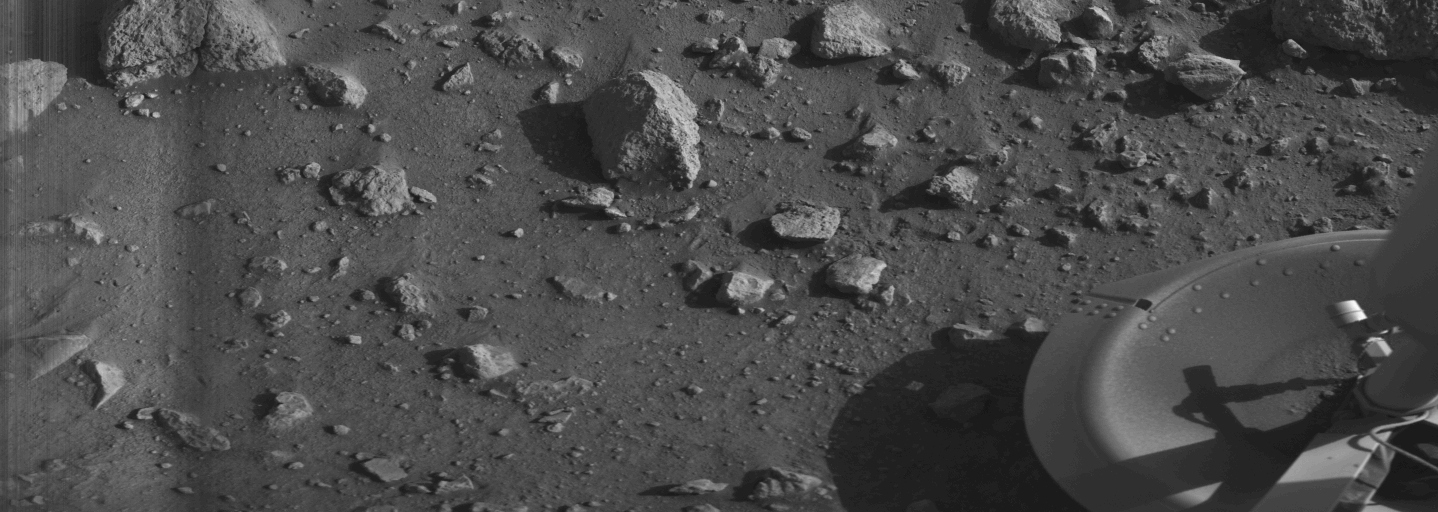

It seemed that with the help of Viking 1, the long-held question of whether life existed on Mars had finally been settled. However, not everyone is convinced that we were unable to find evidence of life at that time. Writing for Scientific American in 2019, Gilbert V. Levin presented the argument that Viking 1 had, in fact, uncovered evidence of life on Mars, which might have been too quickly dismissed as the result of inorganic chemical reactions.
“In summary,” Levin argues, “we have: positive results from a widely-used microbiological test; supportive responses from strong and varied controls; duplication of the LR results at each of the two Viking sites; replication of the experiment at the two sites; and the failure over 43 years of any experiment or theory to provide a definitive nonbiological explanation of the Viking LR results.”
PERHAPS THE QUESTION OF whether life may exist on Mars has not yet been settled after all, a point which only adds to the lasting intrigue that the Red Planet has had on humankind now for centuries. February 2021 will have seen significant advancements toward unlocking Mars and its many mysteries, and in the coming decades there will no doubt be additional discoveries made, once human colonists arrive and are able to carry out studies on-site in the native Martian environment.
Even once humans arrive on Mars, the intrigue of the Red Planet will endure, if not only amplify. Our arrival on a new planet rich with possibilities—and perhaps even a future second home for Earthlings—will introduce a human element to the mystery and wonder that has caused us to remain so captivated by our longtime planetary neighbor.
